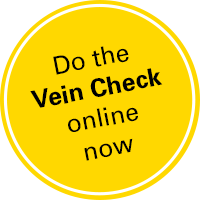Treating varicose veins
The aim of varicose vein treatment is to optimize the blood flow inside the veins, reduce the likelihood of oedema and prevent the occurrence of ulcers.
Consult your physician
People often ignore their varicose veins for a long time. But at the latest, when symptoms such as heaviness, pain, and swelling occur, you should seek medical advice. Only a trained physician such as a GP or phlebologist can help. The earlier vein problems are detected, the lower the risks.
Diagnosis
At the beginning of the examination, the physician lists down the patient’s medical history (anamnesis). In addition to previous thromboses and phlebitis, the clinical pictures of close relatives give an indication of any susceptibility to varicose veins and venous disorders.
Following the anamnesis, the physician examines the legs more closely and in different body positions, as varicose veins usually fill up and bulge during standing and disappear again when the patient lies down. This first impression can be checked more closely, if necessary, by using different methods. For example, the most commonly used Doppler ultrasonic technique allows to measure the direction of movement and the speed of the venous blood. A further development of this method is the duplex and color duplex sonography, which generate an ultrasound image of the blood vessel in addition to the blood flow and can thus give more precise information on the condition and function of the vein.
An x-ray examination of the veins with the aid of contrast media (phlebography) can show the shape and appearance of the veins as well as the valve function and the flow direction of the blood in addition.
Conventional treatment methods
Surgical measures – removal or atrophy of varicose veins – aim to eliminate the causes of vein disorders as completely as possible.
Sclerotherapy
- In this procedure a foam is injected into the vessels and an inflammation is triggered. After the inflammation dies down, the veins become scarred: The varicose vein atrophies.
- Some side effects can occur, such as allergic reactions, nerve damage or migraine-like symptoms.
Stripping
- With stripping, the diseased saphenous vein is completely removed from the leg.
- This surgical procedure is generally carried out under general anesthetic and entails a recuperation time of several weeks.
- Possible complications: numbness or tingling due to injury of the small nerves in the calves if they are damaged when removing the vein.
- Bleeding always occur in the subcutaneous tissue and often painful bruising.
- Lymphedema are possible when lymph vessels are affected.
Radio frequency ablation
- After a catheter is introduced into the vein, the inner wall of the vein is heated using radio waves.
- The wall of the vessel and the adjacent tissue contract. Blood flow is prevented. Within a few weeks, a long, fibrous strand is produced.
- Skin burns can occur when treating veins situated close to the skin surface.
- This method should be used with caution on patients with pacemakers and implantable defibrillators.
Compression therapy
- The basic principle of compression therapy is the reduction of the cross section of the vein by applying pressure from the outside.
- The patients wear compression or support stockings.
- The venous blood flow is accelerated, and swollen legs become slim again.
- Compression treats symptoms, but not the causes of the varicose veins.
-
Compression therapy must be applied continuously.
The innovative laser procedure ELVeS® Radial®
When working with ELVeS® Radial®, the treating doctor guides a probe carefully into the varicose vein via a small puncture. The probe then radiates laser light in a targeted and radial manner. When the probe is pulled back, the vein closes up - just like a zipper. The treatment itself takes only 30 to 45 minutes. A general anesthetic is not necessary, merely local anesthetic is applied. As the treatment is performed outpatiently, no hospital stay is required.
During the procedure as well as afterwards, patients feel only little or even no pain at all. The desired result is recognizable immediately after the treatment, and due to the tiny puncture, pronounced scars are nothing to worry about. Recovery time is short, and patients can resume their everyday activities right after their treatment with ELVeS® Radial®.
Who pays for it?
In an increasing number of cases, the costs are covered by health insurance. Please consult your physician.






